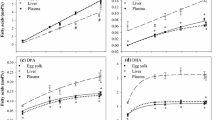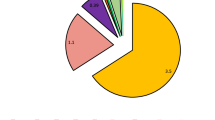Abstract
The effect that egg yolk or maternal n−3 FA have on the cardiac tissue long-chain n−3 FA status of chicks during growth was investigated. Fggs with low, medium, and high levels of n−3 PUFA were obtained by feeding breeder hens a wheat/soybean meal-based diet containing 5% sunflower oil (Low n−3), 2.5% sunflower oil plus 2.5% fish oil (Medium n−3), or 5% fish oil (High n−3). The chicks hatched from Low, Medium, and High n−3 eggs were fed a diet containing 18∶3n−3, but devoid of long-chain n−3 FA. The FA composition of cardiac tissue was determined on days 0, 14, 28, and 42. At day 0, the cardiac FA reflected maternal diet. With time, the level of all the long-chain n−3 FA decreased compared with day 0, and this was true especially by day 14. These data show that dietary 18∶3n−3 fed to the chicks did not sustain high levels of EPA and DHA in cardiac tissue, despite the high content of long-chain n−3 FA in the maternal diet. At days 0 and 14, the chicks hatched from High and Medium n−3 eggs had higher 20∶5n−3, 22∶5n−3, and 22∶6n−3 contents with a concomitant reduction in 20∶4n−6 in the cardiac tissue compared with the Low n−3 egg group. Cardiac tissue of birds hatched from Medium n−3 eggs retained higher levels of 20∶5n−3 up to day 42 of growth when compared with other treatments (P<0.05). None of the treatments was effective in maintaining DHA levels after day 14 of growth.
Similar content being viewed by others
Abbreviations
- AA:
-
arachidonic acid, 20∶4n−6
- DHA:
-
22∶6n−3
- EPA:
-
20∶5n−3
- Low n−3:
-
Medium n−3, and High n−3: diets low, medium, or high in n−3 FA
- SDS:
-
sudden death syndrome
References
Pepe, S., and McLennan, P.L. (2002) Membrane Fatty Acid Composition Modulates Myocardial Oxygen Consumption and Post Ischemic Recovery of Contractile Function, Circulation 105, 2303–2308.
Christensen, J.H. Skou, H.A., Fog, L., Hansen, V.E., Vesterlund, T., Dyerberg, J., Toft, E., and Schmidt, E.B. (2001) Marine n−3 Fatty Acids, Wine Intake, and Heart Rate Variability in Patients Referred for Coronary Angiography, Circulation 103, 651–657.
Nair, S.S., Leitch, J.W., Falconer, J., and Garg, M.L. (1997) Prevention of Cardiac Arrhythmia by Dietary (n−3) Polyunsaturated Fatty Acids and Their Mechanism of Action, J. Nutr. 127, 383–393.
Calder, P.C. (2002) Dietary Modification of Inflammation with Lipids, Proc. Nutr. Soc. 61, 354–358.
Ikeda, I., Yoshida, H., Tomooka, M., Yosef, A., Imaizumi, K., Tsuji, H., and Seto, A. (1998) Effects of Long-Term Feeding of Marine Oils with Different Positional Distribution of Eicosapentaenoic and Docosahexaenoic Acids on Lipid Metabolism, Eicosanoid Production, and Platelet Aggregation in Hypercholesterolemic Rats, Lipids 33, 897–904.
Nestel, P., Shige, H., Pomeroy, S., Cehun, M., Abbey, M., and Raederstorff, D. (2002) The n−3 Fatty Acids Eicosapentaenoic Acid and Docosahexaenoic Acid Increase Systemic Arterial Compliance in Humans, Am. J. Clin. Nutr. 76, 326–330.
Leaf, A., Kang, J.X., Xiao, Y., and Billman, G.E. (2003) Clinical Prevention of Sudden Cardiac Death by n−3 Polyunsaturated Fatty Acids and Mechanism of Prevention of Arrhythmias by n−3 Fish Oils, Circulation 107, 2646–2652.
Olkowski, A.A., and Classen, H.L. (1997) Malignant Ventricular Dysrhythmia in Broiler Chickens Dying from Sudden Death Syndrome, Vet. Rec. 140, 177–179.
Cherian, G., and Sim, J.S. (2001) Maternal Dietary α-Linolenic Acid (18∶3n−3) Alters n−3 Polyunsaturated Fatty Acid Metabolism and Liver Enzyme Activity in Hatched Chicks, Poultry Sci. 80, 901–905.
Wang, Y., Sunwoo, H., Cherian, G., and Sim, J.S. (2000) Fatty Acid Determination in Chicken Egg Yolk: A Comparison of Different Methods, Poultry Sci. 79, 1168–1171.
SAS Institute (1990), SAS User’s Guide: Statistics, Version 6.06, SAS institute Inc., Cary, NC.
Myers, J.L., and Well, A.D. (1995) Research Design and Statistical Analysis, Lawrence Erlbaum Associates, Hillsdale, NJ.
Cherian, G., and Sim, J.S. (1993) Net Transfer and Incorporation of Yolk n−3 Fatty Acids into the Developing Chick Embryos During the Incubation Period, Poultry Sci. 72, 98–105.
Cherian, G., Gopalakrishan, N., Akiba, Y., and Sim, J.S. (1997) Effect of Maternal Dietary n−3 Fatty Acids on the Accretion of Long-Chain Polyunsaturated Fatty Acids in the Tissues of Developing Chick Embryo, Biol. Neonate 72, 165–174.
Salem, N., Jr., Moriguchi, T., Greiner, R.S., McBride, K., Ahmad, A., Catalan, J.N., and Slotnick, B. (2001) Alterations in Brain Function After Loss of Docosahexaenoate Due to Dietary Restriction of n−3 Fatty Acids, J. Mol. Neurosci. 16, 299–307.
Carrié, I., Smirnova, M., Clément, M., de Javel, D., Francès, H., and Bourre, J.M. (2002) Docosahexaenoic Acid-Rich Phospholipid Supplementation: Effect on Behavior, Learning Ability, and Retinal Function in Control and n−3 Polyunsaturated Fatty Acid Deficient Old Mice, Nutr. Neurosci. 5, 43–52.
Kang, J.X., and Leaf, A. (1996) The Cardiac Antiarrhythmic Effects of Polyunsaturated Fatty Acids, Lipids 31, S41-S44.
Gardiner, E.E., Hunt, J.H., Newberry, R.C., and Hall, J.W. (1988) Relationships Between Age, Body Weight, and Season of the Year and Incidence of Sudden Death Syndrome in Male Broiler Chickens, Poultry Sci. 67, 1243–1249.
Ajuyah, A.O., Wang, Y., Cherian, G., Sunwoo, H., and Sim, J.S. (2003) The Effect of Maternal Dietary Omega-3 Fatty Acids on Hatchability and Growth of Broiler Chickens, Proc. Aust. Poult. Sci. Sym. 15, 154–158.
Imaeda, N. (2000) Influence of Stocking Density and Rearing Season on Incidence of Sudden Death Syndrome in Broiler Chickens, Poultry Sci. 79, 201–204.
Author information
Authors and Affiliations
Corresponding author
About this article
Cite this article
Ajuyah, A.O., Cherian, G., Wang, Y. et al. Maternal dietary FA modulate the long-chain n−3 PUFA status of chick cardiac tissue. Lipids 38, 1257–1261 (2003). https://doi.org/10.1007/s11745-003-1186-6
Received:
Revised:
Accepted:
Issue Date:
DOI: https://doi.org/10.1007/s11745-003-1186-6




